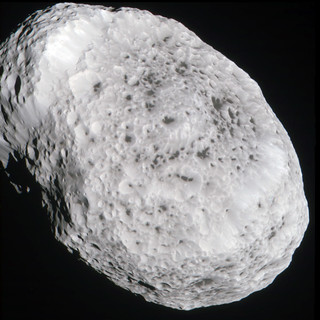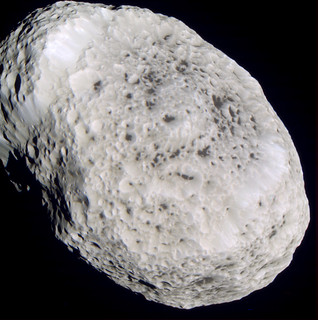
Full Version: Rev 216
Unmanned Spaceflight.com > Outer Solar System > Saturn > Cassini Huygens > Cassini's ongoing mission and raw images
Saturn and Titan as seen on the 23rd, with south pointing up for aesthetic reasons:
Click to view attachment
Click to view attachment
Almost the exact same side as the other flybys. There's little bit of new terrain on the 'southeast' of the big crater though (the southeast of the picture, not the moon!)
Yeah, it's a shame we weren't treated to a close-up view of the other side. Here's another RGB comp at slightly closer range:
Click to view attachment
Click to view attachment
A side-by-side of the large basins on Hyperion and Vesta:
Click to view attachment
Interesting similarities and contrasts.
Click to view attachment
Interesting similarities and contrasts.
That is an inspired comparison. Very instructive.
Phil
Phil
Great new views of Hyperion, even though it's the familiar side we're looking at.
Here's my RGB composite from the raw images:
Click to view attachment
IR-GR-UV composite (filesize too big to be uploaded here:
http://s2.postimg.org/x0ssimk5l/hyperion_irgruv_may2015.jpg
~~~
Cassini did get fairly close views of other sides of the moon, such as this one in Sep 2011:
(RGB composite also by me)
Click to view attachment
Here's my RGB composite from the raw images:
Click to view attachment
IR-GR-UV composite (filesize too big to be uploaded here:
http://s2.postimg.org/x0ssimk5l/hyperion_irgruv_may2015.jpg
~~~
Cassini did get fairly close views of other sides of the moon, such as this one in Sep 2011:
(RGB composite also by me)
Click to view attachment
That 'other side' view is an even better match to the Vesta image just posted. A side-by side of those two might make headlines somewhere.
My personal take on the photos - just to make them look pretty, nothing accurate. Also, please note that they were processed on an iphone, so... yeah. Just ignore this.
What software did you use? Those are nice!
I used an app called Afterlight for basic brightness/contrast/exposure/temperature control. Removed the image artifacts (i.e. bright spots) using Facetune. Did some further editing from my PC but didn't really change much. Thanks :-)
I used an app called Afterlight for basic brightness/contrast/exposure/temperature control. Removed the image artifacts (i.e. bright spots) using Facetune. Did some further editing from my PC but didn't really change much. Thanks :-)
Thanks! It doesn't let you create RGB out of 3 greyscales, does it? A simple app that could do that would be wonderful.
Thanks! It doesn't let you create RGB out of 3 greyscales, does it? A simple app that could do that would be wonderful.
I don't think so, but my parents work for a photographic agency so I might do some research and let you know if there is such a handy app. But it does have some beautiful filters for non-astronomical photos. You're welcome!
I've put together a few images from the Hyperion flyby.
A standard visible RGB view:

Full size here
A couple multispectral images with the IR1, GRN, and UV3 filters:

Full size here

Full size here
I put these together in Photoshop CS5. Individual color frames have been warped and resized to get better alignment of surface features.
A standard visible RGB view:

Full size here
A couple multispectral images with the IR1, GRN, and UV3 filters:

Full size here

Full size here
I put these together in Photoshop CS5. Individual color frames have been warped and resized to get better alignment of surface features.
Hyperion is really dull reddish in colour, isn't it? RGB composites most people post look mostly gray because uncalibrated images are used, from the raw images archive. I'm looking forward to seeing these latest images in the PDS archive, where they will be properly adjusted. What is the time period before we'll see these images in PDS?
I've made some RGB composites from the older Hyperion images found at PDS, but some images come out distinctly reddish, while others are pale-yellowish, so I guess there's still some variation in the calibrated images.
From the September 2011 flyby:
Click to view attachment
When using the raw uncalibrated images and adjusting the resulting RGB composite to make Hyperion reddish, are there any specific settings you use in your graphics software, or is it purely arbitrary?
Thanks.
I've made some RGB composites from the older Hyperion images found at PDS, but some images come out distinctly reddish, while others are pale-yellowish, so I guess there's still some variation in the calibrated images.
From the September 2011 flyby:
Click to view attachment
When using the raw uncalibrated images and adjusting the resulting RGB composite to make Hyperion reddish, are there any specific settings you use in your graphics software, or is it purely arbitrary?
Thanks.
Beautiful shots of this weird place. Does that huge hemisphere-wide basin have a name?
I can see that there are a few named craters on Hyperion, but because I don't know how the coordinate system works, I don't know if the big basin is one of them.
P
I can see that there are a few named craters on Hyperion, but because I don't know how the coordinate system works, I don't know if the big basin is one of them.
P
My impression now is that the body appears to have been elongated (no mechanism proposed, just an observation) and that what many are calling a basin is actually a rift valley with preserved original surface features in the depression. The extension of the fault band around the limb of the moon further complicates the use of "basin" to describe that wrapping effect. Could "spongy" be conflated with "elasticity" as an explanation for Hyperion's peanut shape with what could be described as a rift valley around much of it?
The basin doesn't have a name, but I usually refer to it as Bond-Lassell after the name of the basin wall.
Since we are talking about Hyperion and its basin, and I just noticed that my old paper on it is free online, some folks might like to read this - a Voyager view of Hyperion and the "discovery" of the basin.
http://articles.adsabs.harvard.edu/full/19...%26P...74...61S
This site lets you view one page at a time, but if you click "print this article" at upper right, it will give you a PDF of the full paper. The illustrations don't show up very well, but the relief drawing is available here:
http://publish.uwo.ca/~pjstooke/hyperion.jpg
Phil
http://articles.adsabs.harvard.edu/full/19...%26P...74...61S
This site lets you view one page at a time, but if you click "print this article" at upper right, it will give you a PDF of the full paper. The illustrations don't show up very well, but the relief drawing is available here:
http://publish.uwo.ca/~pjstooke/hyperion.jpg
Phil
Hyperion doesn't look like any other icy moon, although Wikipedia says it is "confirmed" to be made mostly of water ice.
Quote:
The latest analyses of data obtained by NASA's Cassini spacecraft during its flybys of Hyperion in 2005 and 2006 show that about 40 percent of the moon is empty space. It was suggested in July 2007 that this porosity allows craters to remain nearly unchanged over the eons. The new analyses also confirmed that Hyperion is composed mostly of water ice with very little rock.[15]
Unquote.
It looks more like porous rock of some sort. If on Earth, I would be reminded of pumice or even coral.
Despite the low temperatures, it is hard to imagine how ice could maintain the delicate, fluted look for hundreds of millions of years.
The reference is to this article in Space.com, which contains a long string of seemingly unsupported conjectures about how the moon and its craters formed.
http://www.space.com/4028-key-giant-space-...e-revealed.html
Quote:
The latest analyses of data obtained by NASA's Cassini spacecraft during its flybys of Hyperion in 2005 and 2006 show that about 40 percent of the moon is empty space. It was suggested in July 2007 that this porosity allows craters to remain nearly unchanged over the eons. The new analyses also confirmed that Hyperion is composed mostly of water ice with very little rock.[15]
Unquote.
It looks more like porous rock of some sort. If on Earth, I would be reminded of pumice or even coral.
Despite the low temperatures, it is hard to imagine how ice could maintain the delicate, fluted look for hundreds of millions of years.
The reference is to this article in Space.com, which contains a long string of seemingly unsupported conjectures about how the moon and its craters formed.
http://www.space.com/4028-key-giant-space-...e-revealed.html
As a minor diversion, here's a movie utilizing the raw images from the flyby:
https://www.youtube.com/watch?v=diof8JtzSac
https://www.youtube.com/watch?v=diof8JtzSac
it will be nice once this last set is on pds
there are enough to do a fair bit of stereo imaging for a good part of the moon
there are enough to do a fair bit of stereo imaging for a good part of the moon
I moved several posts containing IMG2PNG discussion from this thread to the IMG2PNG thread:
http://www.unmannedspaceflight.com/index.p...st&p=220993
http://www.unmannedspaceflight.com/index.p...st&p=220993
This is a "lo-fi" version of our main content. To view the full version with more information, formatting and images, please click here.

